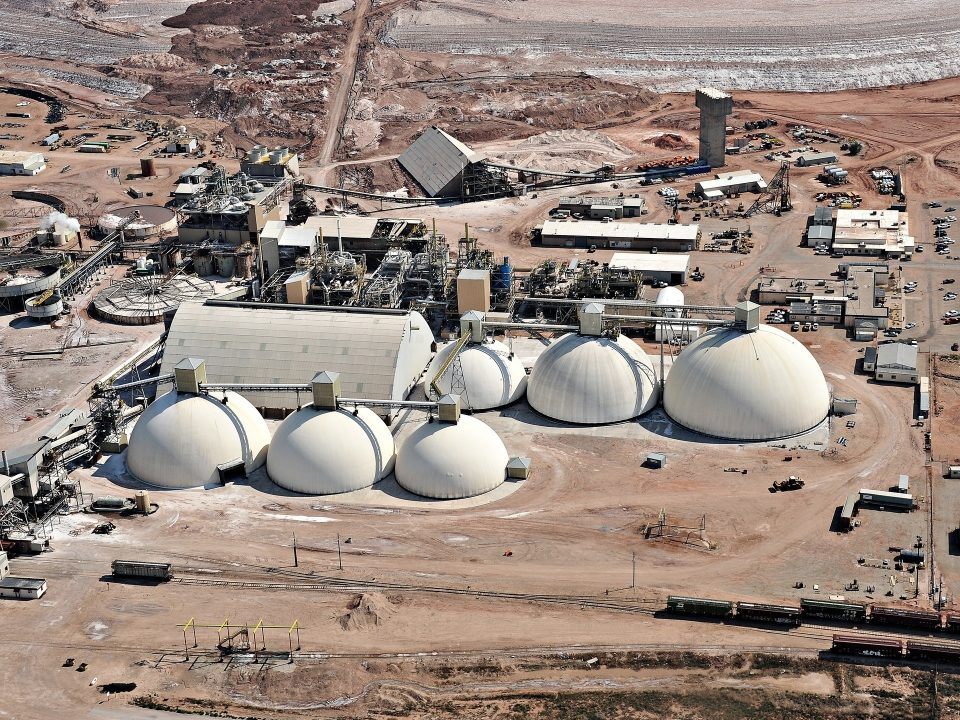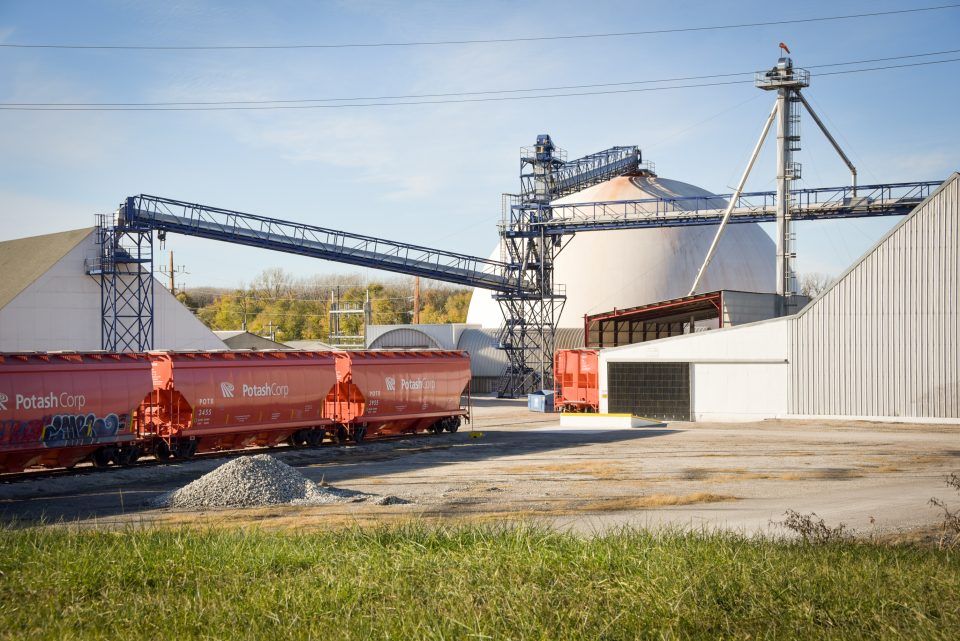Because fertilizer will corrode exposed steel in storage, figuring out creative solutions is key to cutting down on regular maintenance and replacement costs.
Such was the case with for one fertilizer company in Carlsbad, New Mexico, USA, that needed new storage after a microburst damaged its A-frame storing fertilizer. The company selected six steel-reinforced concrete domes from Dome Technology based partly on corrosion prevention. Steel reinforcing gives the domes their strength, but since the entire dome interior is made of concrete, the storage structure will not corrode.

Concrete will have hairline cracks that can be penetrated by fine fertilizer dust. This was not a concern expressed by this potash customer; however, other urea customers have had concerns that were mitigated by spraying a polyurea coating on the interior surface of the dome. A corrosive-resistant powder can also be mixed into the concrete when pouring the floor.
Water wreaks havoc on fertilizer, and since most fertilizers are hygroscopic, they attract moisture that dissolves the product and corrodes it too, producing weak acids that break down steel and damage concrete. Dome customers are advised to allot a portion of the budget to corrosive-resistant rebar and/or additional concrete over rebar.
To protect product from humidity, a dehumidifier is also highly recommended. Housed on top of the dome, humidity in the headspace can be controlled, and the ideal interior climate can be maintained. Humidity monitors can also be installed, allowing site managers to survey and adjust interior conditions.
Moisture and rust prevention on the storage side is one thing, but there are ways to extend a facility’s life span by protecting other components from corrosion too. While many fertilizer storage companies utilize front-end loaders, those who select integrated reclaim systems can protect metal components from rust in multiple ways. Stainless steel is always an option, especially ideal for food- or pharm-grade fertilizer products, but can be cost prohibitive. Another route is to paint the metal so corrosion isn’t an issue; the main thing to remember is to keep up on maintenance so chips and scratches in the surface don’t allow an access point for moisture.
With rust prevented, there are other ways domes ensure a longer lifespan than traditional fertilizer storage:
Low maintenance
A continuous single-ply PVC waterproofing membrane ensures complete waterproof protection for the reinforced concrete shell and consequently the material stored within. A mold-resistant UV-protective resin coats both sides of the membrane, providing long-term protection from these two common sources of degradation. No other silo option offers this type of waterproof protection, and this exterior requires almost zero superficial maintenance.
Rivets, fasteners or other mechanical connections found in other storage are not used, thus eliminating potential sources for leaks and rust. This comprehensive approach to waterproofing promises long-lasting protection for stored product and the structure itself.

Longevity
Dome Technology’s steel-reinforced concrete domes are the most durable bulk-storage structures on the market. In an industry where traditional concrete and steel silos have a history of multiple failures, Dome Technology’s domes have withstood earthquakes, hurricanes and the test of time with a remarkable success rate.
Because fertilizer is hygroscopic, some companies opt for wooden warehouses since wood is naturally inert; however, a concrete dome designed to hold the same amount of material is significantly less expensive.
Two major perks for storing fertilizer in a dome are economy and longevity. Much of the cost savings in a dome comes over the long term from humidity control and finish options that protect the product. A dome is built to last decades.
Protection from explosion
Real-world examples have demonstrated that the always-in-compression double-curvature geometry of a dome is structurally stable under extreme fire and heat conditions. The reinforced concrete dome also provides excellent explosion containment. The smooth interior surface discourages build-up or caking of dust and stored materials, which have potential to self-combust or when dislodged can cause fire or explosion. These reduced risks offer potential insurance premium savings.
Until now, square and rectangular explosion venting has been the norm in storing products prone to deflagration, but Dome Technology’s team has pioneered a round hybrid model that began to be installed on projects in 2016. No matter the system a weak spot is created with panels. But since this is a round panel, sharp corners that would act as stress concentrators are eliminated.
The proprietary explosion vents are comprised of a metal ring fastened directly to the dome with pressure-release screws; these screws are engineered to remain secure through dead, live and wind loads but will release should interior pressure reach critical levels. To the metal ring is fastened another ring, this one attached to a geodesic steel lattice covered with fabric. The lattice helps the fabric hold its shape, and the fabric acts as a waterproofing shield protecting product and helping maintain the dome’s interior climate.
When an explosion occurs, the fabric accepts the load and transfers it uniformly around the ring’s circumference. “Because it’s circular we can predict the load going to each of the fasteners really well,” said Jason South, Dome Technology Vice President of Engineering, Research and Development. “If it were rectangular, the pressure going to each fastener could be different,” and more difficult to estimate.
Each explosion vent is unique to the project. Dome Technology’s engineering team provides building parameters to explosion experts who calculate discrete finite element modeling and computational fluid dynamics, modeling the explosion to determine the amount of area required for the blast panels such that the pressure only reaches a certain level before fasteners release, South said. The modeling information also provides information about the load imposed on the dome structure to aid in the structural engineering.
With a defined amount of required surface area, Dome Technology’s team sizes the explosion vents and places them in locations where they’ll vent adequately and function structurally.
According to South, this type of explosion venting is durable and strong; the only failure point is at the fasteners, which pop at the precise pressure threshold. Vents are tethered to the dome structure, so they do not become a projectile when loosed. Usually upon an explosion event, the vents and the surrounding venting structure are damaged beyond repair and will need to be replaced, but in this arrangement the dome and base ring of the vent will likely be intact and functional. The outer ring and the fabric can be replaced very economically.

Product integrity + greater storage
For one major chemical company in the United States, crystal bridging was really becoming a problem. The company was shipping low-density ammonium nitrate via train, but because they did not have adequate means for curing, the product clumped together via transit, making it difficult to remove upon arrival to the customer.
In an effort to solve that problem in a big way, Dome Technology was contracted to build one dome, and eventually a second one, that would provide ample storage and the ability to keep different types of ammonium nitrate separate.
Initially the plan was simple: To construct a single dome designed to hold low-density ammonium nitrate. Dome Technology built the dome, which stands 99 feet tall and 198 feet in diameter and has a maximum storage of 16,000 tons. The dome is fed at the apex, where product is stacked in a kidney-shaped pile. A chute rotates to lay the pile in a thin layer that allows for better cooling, thus avoiding a deep pile where the center would never adequately cool. Maximum convey rate to the dome is 450 tons per day, and the reclaim rate is 800 tons per day.
The dome is temperature and humidity controlled, and a smoke-detection system ties in with louvers so that should fire be present, a fan will kick on to blow out fumes that could explode. The pile depth is capped at 45 feet to prevent degradation.
The low-density product cures in 10 to 20 days, then is ready for shipping via truck or rail to be used in explosive applications. By allowing it to adequately cure, crystal bridging is far less likely, resulting in better flow and a better product for customers.
As construction for Dome 1 was underway, the customer decided a second dome would be a good idea, this one to store high-density ammonium nitrate. This dome is designed to provide storage, allowing the company to keep up with spring-season demand.
Product in the second dome can be stacked deeper and is center filled because it doesn’t have the curing issues that low-density ammonium nitrate does. The customer fills the second dome completely to fully utilize the storage volume, Aagard said.
Both domes feature a ring-beam foundation, standard in dome construction, and soil improvement was completed prior to construction to set the stage for solid foundations. For both domes, a front-end loader reclaims product, dumps it into a hopper, and the hopper feeds to conveyors. But having two separate domes with distinct reclaim systems ensures that product types are never mixed.
In 10 months both domes and their conveyor systems were complete, customized specifically to the customer’s requests and providing the protection both types of ammonium nitrate demand.
“As we have seen over the course of several years, Dome Technology can offer solutions for material storage and handling for a wide range of storage needs. I am happy that Dome Technology was able to offer and provide solutions for this facility in storing their product,” Dome Technology project manager Jason Craig said.
Investing in a dome and partnering with a dome expert is an investment in the future. Dome storage is built to resist elements that would compromise the structure over time and could reduce product quality. Dome Technology is one company that can provide a longer facility lifespan while preventing rust and structural corrosion.
By Rebecca Long Pyper for Dome Technology
Editor’s note: This article was published in the online edition of World Fertilizer May/June 2020. The full issue can be accessed here; to subscribe for a free regular digital copy of the magazine, click here.
